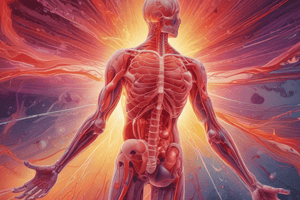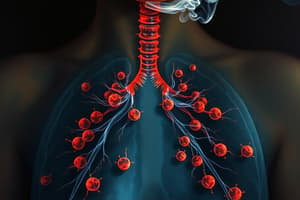Podcast
Questions and Answers
Which hormone plays a vital role in follicular maturation, rupture, and ovulation?
Which hormone plays a vital role in follicular maturation, rupture, and ovulation?
- Testosterone
- LH (correct)
- Prolactin
- FSH
Elevated levels of Prolactin are observed in primary hypothyroidism.
Elevated levels of Prolactin are observed in primary hypothyroidism.
True (A)
What is the main role of cortisol in the body?
What is the main role of cortisol in the body?
respond to stress
Thyroid hormone test is used to diagnose symptoms of either an underactive thyroid (hypothyroidism) or an overactive thyroid (hyperthyroidism). TSH may used alone or a combination of TSH, T4, and ___ tests to diagnose thyroid disorders.
Thyroid hormone test is used to diagnose symptoms of either an underactive thyroid (hypothyroidism) or an overactive thyroid (hyperthyroidism). TSH may used alone or a combination of TSH, T4, and ___ tests to diagnose thyroid disorders.
Match the following trace elements with their biological functions:
Match the following trace elements with their biological functions:
What are the four cardinal signs of inflammation?
What are the four cardinal signs of inflammation?
What is the normal range of total lipid level in blood plasma in fasting conditions?
What is the normal range of total lipid level in blood plasma in fasting conditions?
What is the purpose of inflammation?
What is the purpose of inflammation?
What type of leukocytes are the main phagocytes involved in acute inflammation? Neutrophils and _______.
What type of leukocytes are the main phagocytes involved in acute inflammation? Neutrophils and _______.
Which of the following diseases can be caused by elevated lipid levels in blood?
Which of the following diseases can be caused by elevated lipid levels in blood?
Chronic inflammation is always a sequel to acute inflammation.
Chronic inflammation is always a sequel to acute inflammation.
Maple Syrup Urine Disease results from a defective branched-chain α-keto acid dehydrogenase complex, causing the accumulation of ___, ___ and ___ in the blood and urine.
Maple Syrup Urine Disease results from a defective branched-chain α-keto acid dehydrogenase complex, causing the accumulation of ___, ___ and ___ in the blood and urine.
Where is C-reactive protein (CRP) manufactured in the body?
Where is C-reactive protein (CRP) manufactured in the body?
CRP levels rise moderately during the early phase of an inflammatory stimulus.
CRP levels rise moderately during the early phase of an inflammatory stimulus.
What is the role of lipids in the body?
What is the role of lipids in the body?
Following the absorption of lipids, chylomicrons enter the ductus thoracicus, imparting ______ color to the plasma.
Following the absorption of lipids, chylomicrons enter the ductus thoracicus, imparting ______ color to the plasma.
Match the following lipid disorders with their definitions:
Match the following lipid disorders with their definitions:
What are the main sources of iron?
What are the main sources of iron?
Which enzyme is deficient in Type I: Von Gierke's disease?
Which enzyme is deficient in Type I: Von Gierke's disease?
In Type II: Pompe's Disease, the enzyme lysosomal alpha 1-4 glycosidase is missing.
In Type II: Pompe's Disease, the enzyme lysosomal alpha 1-4 glycosidase is missing.
Cobalt is a structural component of ________ (vitamin B12).
Cobalt is a structural component of ________ (vitamin B12).
Match the disorder with the correct description:
Match the disorder with the correct description:
What is the normal range of total lipid level in blood plasma in fasting conditions?
What is the normal range of total lipid level in blood plasma in fasting conditions?
Which genetic disorder is caused by a defect in phenylalanine hydroxylase enzyme?
Which genetic disorder is caused by a defect in phenylalanine hydroxylase enzyme?
Estriol is the most potent estrogen.
Estriol is the most potent estrogen.
_______ is the hormone known as the 'hormone of pregnancy'.
_______ is the hormone known as the 'hormone of pregnancy'.
Match the following reproductive hormones with their descriptions:
Match the following reproductive hormones with their descriptions:
What is the common deficiency or disorder of the phenylalanine hydroxylase enzyme?
What is the common deficiency or disorder of the phenylalanine hydroxylase enzyme?
Which enzymes are required for the conversion of phenylalanine to tyrosine in PKU?
Which enzymes are required for the conversion of phenylalanine to tyrosine in PKU?
Persons with PKU tend to have darker features such as dark hair and brown eyes.
Persons with PKU tend to have darker features such as dark hair and brown eyes.
What characteristic smell is associated with Maple syrup urine disease (MSUD)?
What characteristic smell is associated with Maple syrup urine disease (MSUD)?
Match the disorder with its associated characteristic:
Match the disorder with its associated characteristic:
What do disorders of peroxisomal function cause in individuals with Zellweger syndrome?
What do disorders of peroxisomal function cause in individuals with Zellweger syndrome?
Dozens of congenital metabolic diseases are now detectable by newborn screening tests, especially expanded testing using __________.
Dozens of congenital metabolic diseases are now detectable by newborn screening tests, especially expanded testing using __________.
Flashcards are hidden until you start studying
Study Notes
Inflammation
- Inflammation is a response triggered by damage to living tissues
- Purpose: to protect from infection and injury, to localize and eliminate the injurious agent and to remove damaged tissue components
- Consists of changes in blood flow, permeability of blood vessels, and migration of fluid, proteins, and white blood cells (leukocytes) to the site of tissue damage
Causes of Inflammation
- Microorganisms (viruses, bacteria)
- Physical agents (trauma, burns, radiation injury, frostbite)
- Chemicals (corrosive substances, acids, alkalis, oxidizing agents)
- Immunological responses (allergic, autoimmune reactions)
- Tissue death (lack of oxygen or nutrients)
Signs of Inflammation
- Redness (dilation of small blood vessels)
- Heat (increased blood flow)
- Swelling (edema, accumulation of fluid outside blood vessels)
- Pain (distortion of tissues, chemical mediators)
- Loss of function of the inflamed area
Types of Inflammation
- Acute inflammation (response lasts only a few days)
- Chronic inflammation (response of longer duration)
Acute Inflammatory Response
- Vascular changes:
- Vasoconstriction (momentary)
- Vasodilation (increase blood flow)
- Increased permeability of blood vessels
- Cellular changes:
- Phagocytes (neutrophils, monocytes)
- Release of chemical mediators
- Increased blood flow and permeability lead to exudate formation
Chronic Inflammation
- If the agent causing inflammation cannot be eliminated or healing process is impaired
- Repeated episodes of acute inflammation can also lead to chronic inflammation
- Examples: tuberculosis, rheumatoid arthritis, chronic lung disease
Diagnosis of Inflammation
- Tests:
- C-Reactive Protein (CRP) level
- Erythrocyte Sedimentation Rate (ESR)
- White blood cell count### Lipid and Lipoprotein Analyses
- Renal failure can lead to increased serum triglyceride levels due to impaired removal of large molecular-weight constituents.
- Hypertriglyceridemia is often caused by an imbalance between VLDL synthesis and clearance in the circulation.
- Cholesterol can be estimated using colorimetric or enzymatic methods, such as the Salkowski reaction, which involves the formation of a red color with sulfate acid, and the Liebermann-Burchard reaction, which involves the formation of a green color with sulfuric acid.
Cholesterol Measurement
- The traditional lipid workup begins with the measurement of total serum cholesterol.
- Early analytic methods used strong acids, such as sulfuric and acetic acids, to produce a measurable color with cholesterol.
- The current reference method for cholesterol uses hexane extraction after hydrolysis with alcoholic KOH, followed by reaction with the Liebermann-Burchard color reagent.
- Enzymatic reagents have generally replaced strong acid chemistries in the routine laboratory.
Lipoprotein Measurements
- HDL and LDL are quantified based on their cholesterol content.
- The common lipid panel includes measurements of total, LDL, and HDL cholesterol, as well as triglycerides.
Liebermann-Burchard Method
- The method involves a sequence of reactions to measure cholesterol.
- Cholesteryl ester hydrolase cleaves the fatty acid residue from cholesteryl esters, converting them to free cholesterol.
- Cholesterol oxidase reacts with free cholesterol to produce hydrogen peroxide, which is then coupled with a chromogen to produce a colored compound.
- The intensity of the resulting color is proportional to the amount of cholesterol.
Salkowski Test
- The Salkowski test is a qualitative method for determining cholesterol.
- Cholesterol is dissolved in organic solvents, such as ether or chloroform, and then treated with strong acids, such as sulfuric acid.
- The oxidation of cholesterol produces a cherry-red color.
Phosphovanilin Method
- The Phosphovanilin method is a colorometric assay for lipid measurement.
- Lipids react with sulfuric acid to form carbonium ions, which then react with vanillin phosphate ester to produce a purple complex.
- The absorbance of the complex is measured at 530 nm, and the intensity of the color is proportional to the total lipid concentration.
Clinical Significance
- The normal range of total lipid levels in blood plasma is 400-700 mg/dL in fasting conditions.
- Hyperlipidemia is an elevated lipid level in the blood, which increases the risk of cardiovascular disease.
- Hyperlipidemia can be observed after a high-fat diet, and it is important to fast before lipid tests.
Disorders of Amino Acid Metabolism
Six Amino Acids Degraded to Pyruvate
- Alanine, tryptophan, cysteine, serine, glycine, and threonine are degraded to pyruvate.
Glycine Degradation
- Glycine is degraded to glyoxylate, which is then oxidized to oxalate.
- Oxalate can form crystals, which can account for up to 75% of all kidney stones.
Seven Amino Acids Degraded to Acetyl-CoA and/or Acetoacetyl-CoA
- Tryptophan, lysine, phenylalanine, tyrosine, leucine, isoleucine, and threonine are degraded to acetyl-CoA and/or acetoacetyl-CoA.
- Some of the intermediates in tryptophan catabolism are precursors for the synthesis of other biomolecules, such as nicotinate, serotonin, and indoleacetate.
Phenylketonuria (PKU)
- PKU is a genetic defect in phenylalanine hydroxylase, which leads to elevated levels of phenylalanine in the blood.
- Phenylalanine hydroxylase requires the cofactor tetrahydrobiopterin, which carries electrons from NADPH to O2.
- Without treatment, PKU can cause severe intellectual disability.
Alkaptonuria
- Alkaptonuria is a genetic defect in homogentisate dioxygenase, which leads to the excretion of homogentisate in the urine.
- The oxidation of homogentisate turns the urine black.
Albinism
- Albinism affects the production of melanin, which is derived from tyrosine.
- Deficiency in the production of tyrosine leads to patches of unpigmented hair.
Four Amino Acids Converted to Succinyl-CoA
- Methionine, isoleucine, threonine, and valine are converted to succinyl-CoA.
Methylmalonic Acidemia
- Methylmalonic acidemia is a genetic defect in methylmalonyl-CoA mutase, which leads to the accumulation of methylmalonyl-CoA.
- Without treatment, methylmalonic acidemia can cause severe symptoms, including seizures, vomiting, and lethargy.
Branched-Chain Amino Acids
- The branched-chain amino acids, leucine, isoleucine, and valine, are not degraded in the liver.
- They are oxidized as fuels primarily in muscle, adipose, kidney, and brain tissue.
Maple Syrup Urine Disease
- Maple syrup urine disease is a genetic defect in the branched-chain α-keto acid dehydrogenase complex, which leads to the accumulation of the three branched-chain α-keto acids.
- Without treatment, maple syrup urine disease can cause abnormal development of the brain and death in early infancy.
Homocystinuria
- Homocystinuria is a disorder of methionine metabolism, which leads to the accumulation of homocysteine and its metabolites in the blood and urine.
- Homocystinuria can cause intellectual disability, seizures, and cardiovascular disease.### Cushing's Syndrome
- Affects 3 times as many women as men
- Can cause health problems such as:
- Heart attack and stroke
- Blood clots in legs and lungs
- High blood pressure
- Unhealthy cholesterol levels
- Depression or mood changes
- Memory loss or trouble concentrating
- Insulin resistance and prediabetes
- Type 2 diabetes
Hormones
- Parathyroid hormone (PTH):
- Secreted by parathyroid glands in the neck region
- Regulates blood calcium levels
- Insulin:
- Lowers blood sugar levels
- Stimulates metabolism of glucose, protein, and lipids
- Produced in the pancreas
- Glucagon:
- Raises blood sugar levels
- Produced in the pancreas
- Erythropoietin:
- Affects red blood cell production
- Produced in the kidneys
- Renin and angiotensin:
- Controls blood pressure
- Regulates aldosterone production from adrenal glands
- Produced in the kidneys
Trace Elements
- Copper (Cu):
- Essential element in human growth and development
- Important for oxidation and reduction reactions
- Found in brain, kidney, heart, bone, and muscle
- Daily requirement: 0.5-0.7 mg/day in children, 2-3 mg in adults
- Sources: liver, walnuts, hazelnuts, legumes, shellfish, green vegetables, and milk
- Zinc (Zn):
- Essential element in human growth and development
- Stabilizes protein structures
- Important for immune system
- Found in skin, muscles, bones, prostate gland, semen, liver, and sac
- Daily requirement: about 15 mg
- Sources: meat, fish, milk, and dairy products
- Iron (Fe):
- Essential element in human growth and development
- Important for oxygen transport in the body
- Found in hemoglobin and myoglobin structures
- Daily requirement: 1 mg/day in men, 8 mg/day in women
- Sources: liver, kidney, heart, offal, egg yolk, fish, oysters, beans, spinach, wheat, and oatmeal
- Cobalt (Co):
- Essential element in human growth and development
- Found in cobalamin (vitamin B12) structure
- Important for erythropoiesis and nerve function
- Sources: vegetables and fruits
- Chromium (Cr):
- Important for glucose metabolism
- Found in brewer's yeast, molasses, and whole wheat
- Selenium (Se):
- Antioxidant properties
- Found in glutathione peroxidase, iodothyronine deiodinases, and thioredoxin reductase structures
- Important for thyroid hormone synthesis and metabolism
- Sources: plant-based foods, animal products, and human milk
Congenital Metabolic Defects
- Disorders of carbohydrate metabolism:
- Glycogen storage disease
- G6PD deficiency
- Disorders of amino acid metabolism:
- Phenylketonuria
- Tyrosinemia
- Maple syrup urine disease
- Disorders of fatty acid metabolism:
- Urea cycle defects
- Lysosomal storage disorders:
- Gaucher's disease
- Niemann-Pick disease
- Disorders of peroxisomal function:
- Zellweger syndrome
Studying That Suits You
Use AI to generate personalized quizzes and flashcards to suit your learning preferences.




